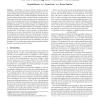Free Online Productivity Tools
i2Speak
i2Symbol
i2OCR
iTex2Img
iWeb2Print
iWeb2Shot
i2Type
iPdf2Split
iPdf2Merge
i2Bopomofo
i2Arabic
i2Style
i2Image
i2PDF
iLatex2Rtf
Sci2ools
111
Voted
ECAI
2010
Springer
2010
Springer
Brothers in Arms? On AI Planning and Cellular Automata
AI Planning is concerned with the selection of actions towards achieving a goal. Research on cellular automata (CA) is concerned with the question how global behaviours arise from local updating rules relating a cell to its direct neighbours. While these two areas are disparate at first glance, we herein identify a problem that is interesting to both: How to reach a fixed point in an asynchronous CA where cells are updated one-by-one? Considering a particular local updating rule, we encode this problem into PDDL and show that the resulting benchmark is an interesting challenge for AI Planning. For example, our experiments determine that, very atypically, an optimal SAT-based planner outperforms state-of-the-art satisficing heuristic search planners. This points to a severe weakness of current heuristics because, as we prove herein, plans for this problem can always be constructed in time linear in the size of the automaton. Our proof of this starts from a high-level argument and then r...
AI Planning | Artificial Intelligence | ECAI 2010 | Local Updating Rule | Optimal Sat-based Planner |
| Added | 06 Dec 2010 |
| Updated | 06 Dec 2010 |
| Type | Conference |
| Year | 2010 |
| Where | ECAI |
| Authors | Jörg Hoffmann, Nazim Fatès, Héctor Palacios |
Comments (0)

